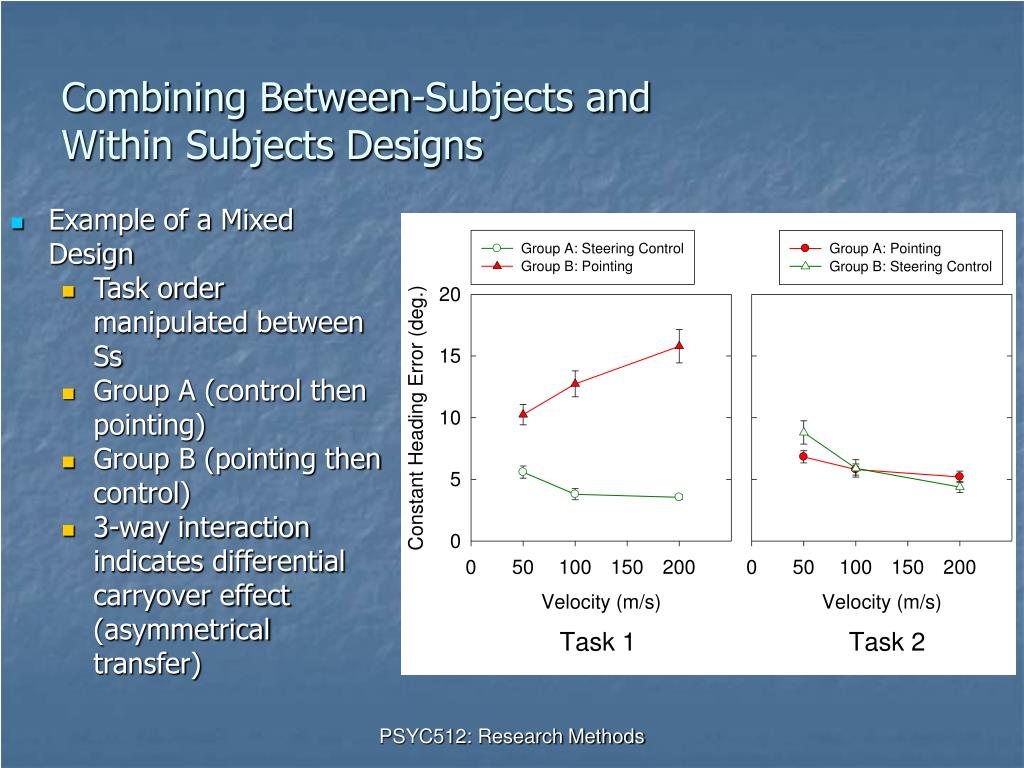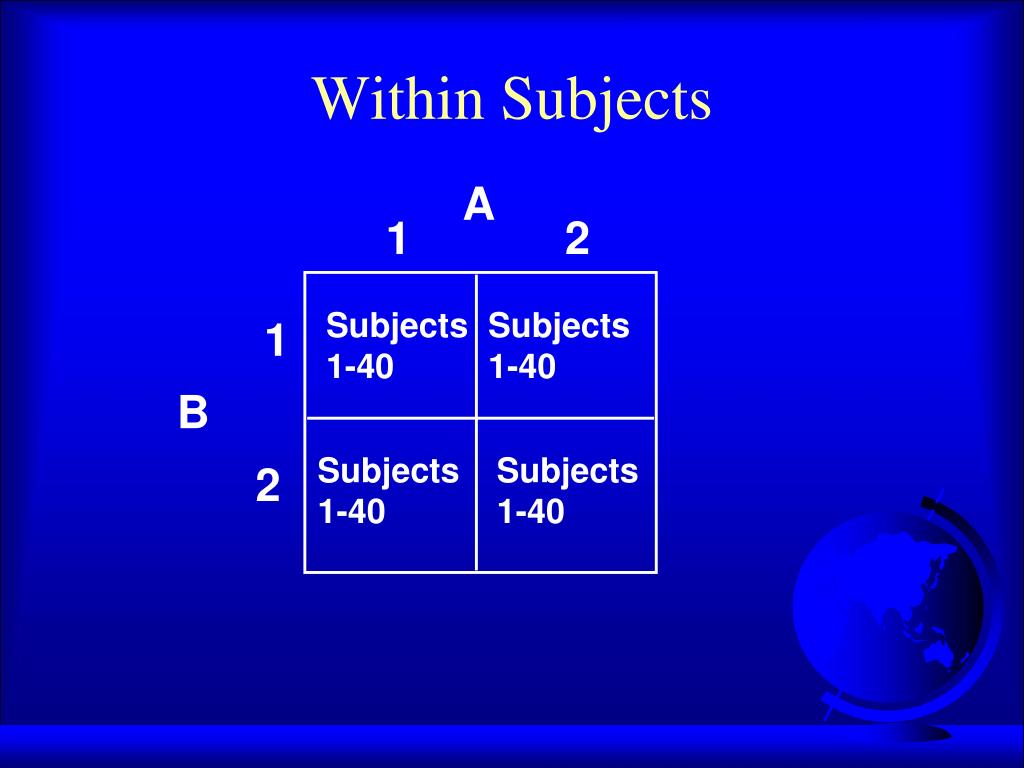Table Of Content

Saul Mcleod, PhD., is a qualified psychology teacher with over 18 years of experience in further and higher education. He has been published in peer-reviewed journals, including the Journal of Clinical Psychology. Julia Simkus is a graduate of Princeton University with a Bachelor of Arts in Psychology.
Approaches to Dealing with Violations of Sphericity
Within-subjects designs do not have a control group as all participants are tested both before and after they are exposed to treatment. In factorial designs, two or more independent variables are tested at the same time. Every level of one independent variable is combined with each level of every other independent variable to create different conditions. One is that it controls the order of conditions so that it is no longer a confounding variable. Instead of the attractive condition always being first and the unattractive condition always being second, the attractive condition comes first for some participants and second for others. Likewise, the unattractive condition comes first for some participants and second for others.

Removes effects of individual differences between conditions
In fact, professional researchers often take exactly this type of mixed methods approach. Almost every experiment can be conducted using either a between-subjects design or a within-subjects design. This possibility means that researchers must choose between the two approaches based on their relative merits for the particular situation. Each type of experimental design has its own advantages and disadvantages, and it is usually up to the researchers to determine which method will be more beneficial for their study.
Smaller sample
The previous chapter focused on a first design principle, the between-subjects design, where each subject participates only in one experimental condition. Between-subjects studies require at least twice as many participants as a within-subject design, which also means twice the cost and resources. In a between-subjects design (or between-groups, independent measures), the study participants are divided into groups, and each group is exposed to one treatment or condition. Understanding how a within-subjects design works can give you a better idea of how psychology experiments are conducted. It can also help give you a better idea of the type of design you might want to use if you are conducting your own psychology experiment.
You can apply both within-subject and between-subject designs in some cases, for instance, if you’re investigating whether e-commerce sites (independent variable) influence levels of consumer spending (dependent variable). Psychologists often use them to test the relative effectiveness of a new treatment, often a difficult proposition. The sheer complexity of the human mind and the large number of potential confounding variables often renders between subjects designs unreliable, especially when necessarily small sample groups make a more random approach impossible. In a between-subjects design, every participant experiences only one condition, and researchers assess group differences between participants in various conditions. Placebo effects are interesting in their own right (see Note 6.28 “The Powerful Placebo”), but they also pose a serious problem for researchers who want to determine whether a treatment works.
Contents
It could be instead that participants in the treatment group improved more because they expected to improve, while those in the no-treatment control condition did not. When using a within-subjects design, it is important to make sure that all of the participants are exposed to the same treatment variables. By doing this, researchers can measure how each participant changes over time as a result of the treatment. In a mixed factorial design, researchers will manipulate one independent variable between subjects and another within subjects. In a between-subjects design, researchers will assign each subject to only one treatment condition. In contrast, in a within-subjects design, researchers will test the same participants repeatedly across all conditions.

Cultural distances between home and host countries inspire sojourners to engage in intercultural exchange upon ... - Nature.com
Cultural distances between home and host countries inspire sojourners to engage in intercultural exchange upon ....
Posted: Mon, 16 Oct 2023 07:00:00 GMT [source]
The former are called between-subjects experiments and the latter are called within-subjects experiments. Between-subjects and within-subjects designs are two different methods for researchers to assign test participants to different treatments. In a within-subjects design, all participants are drawn from a single sample and are exposed to identical conditions to measure changes over time or due to different conditions (also known as “treatments”).
In addition, it can be challenging to control the effects of time on the study’s outcomes. On the other hand, a between-subjects study would require at least twice as many participants as a within-subject design. A between-subjects design is the opposite of a within-subjects design, as each participant is subjected to only one condition, and the group means are then compared. This gives as many data sets as there are conditions for each participant; the fact that subjects act as their own control provides a way of reducing the amount of error arising from natural variance between individuals. Whether your experimental design is within-subjects or between-subjects, you will have to be concerned with randomization, although in slightly different ways. Within-subjects designs have many potential threats to internal validity, but they are also very statistically powerful.
By comparing the average blood pressure of the two groups, the effect of the medication on blood pressure can be assessed, but researchers cannot directly compare the blood pressure of individual participants. Researchers often find themselves choosing from a between-subjects design and a within-subjects one. These two options are opposites in many ways, and making the correct choice means understanding the unique differences between the two, as well as their strengths and weaknesses.
When it comes time to choose the design that meets your study’s needs, a good rule of thumb is to determine whether the differences you're looking to study are between subjects or within subjects. The error reflects the degree to which the effect of dosage is different for different subjects. If subjects all responded very similarly to the drug, then the error would be very low. For example, if all subjects performed moderately better with the high dose than they did with the placebo, then the error would be low. On the other hand, if some subjects did better with the placebo while others did better with the high dose, then the error would be high.
It can be a helpful way for researchers to learn more about how changes happen over time. This type of design can be helpful when resources are limited or when investigating the real-world effects of treatments or programs. The term "treatment" describes the different levels of the independent variable, the variable that the experimenter controls. In other words, all of the subjects in the study are treated with the critical variable in question. One reason researchers use within-group designs is to control for individual differences.

No comments:
Post a Comment